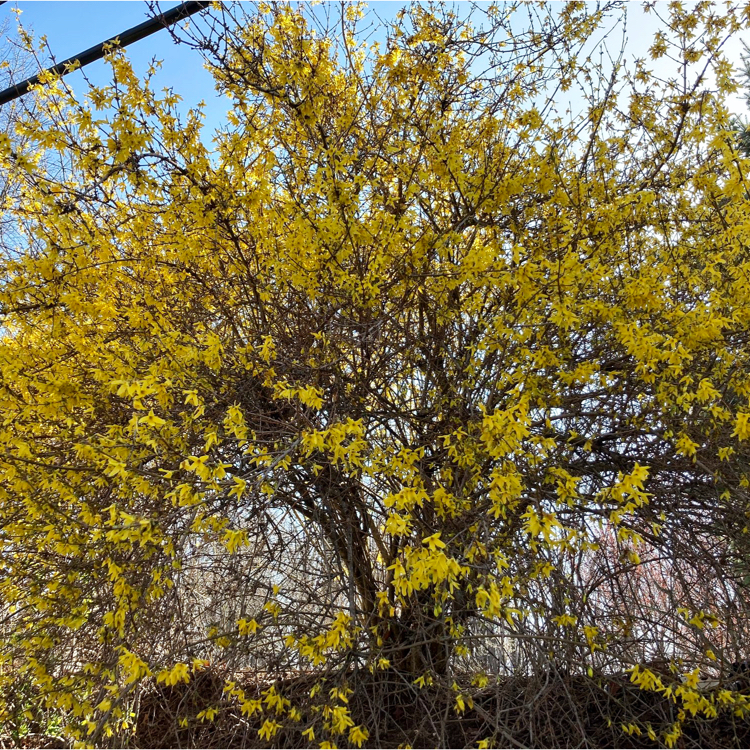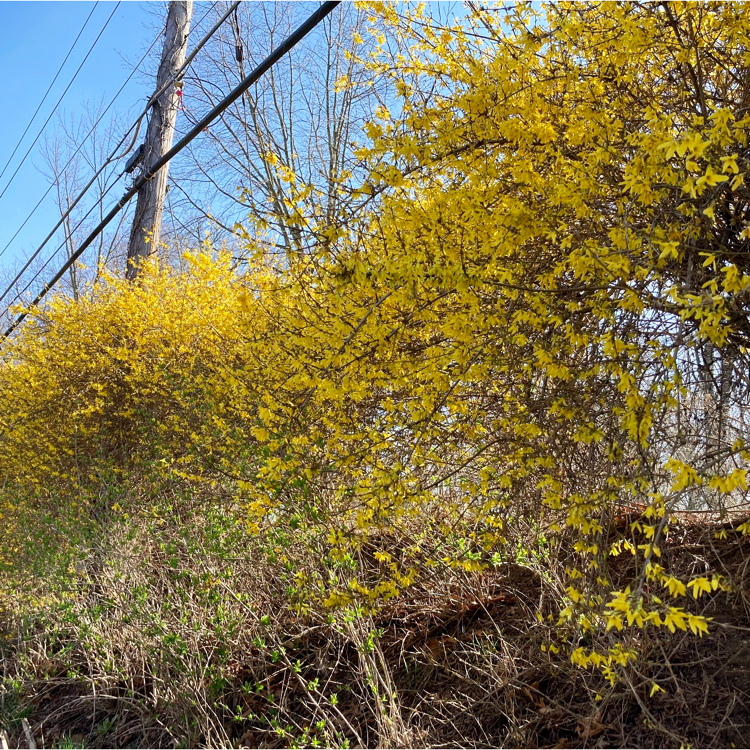
Naturally sprawling Forsythia
Forsythia is known for its show-stopper bright yellow blooms early in the spring season. You can't escape noticing them, even at high speeds in the car. They're bright, cheery, and oh so yellow!
Their long wild bud-covered branches burst into a bright yellow shower of blooms, all before the green leaves emerge to soften the visual display. They're a welcome sight in a predominately brown landscape, at least here in the Midwest.
Eager gardeners welcome the season by gathering bundles of colorful sticks, filling giant vases, buckets, or wide-mouth mason jars to bring these Golden Bells inside. You could fill buckets and buckets of them and hardly even notice the impact on these giant wild-looking plants.
Although this is where my opinions begin to creep in.
The form of the Forsythia plant
Forsythia has a naturally wild and almost unwieldy look to it. It wants to grow upwards and out, and it aggressively takes the space it needs to feel comfortable in its little corner of the landscape. Multiple plants make great sweeping hedges, given enough space, and what I'll sum up as pruning-neglect.
The problem comes in when gardeners love the blooms but don't love the shape of the plant. Hedge shears, power saws, loppers; the amateur gardener is determined to reign in this wild beast and coax it to a more socially acceptable shape and size. After spending what could be hours of sweat-inducing labor, this mighty gardener might quip a satisfied smile, having conquered the wild and crazy Forsythia bush!
The resilient Forsythia will forge on, but probably not in the way said gardener was hoping.

Forsythia hedge, over-pruned
Flower buds grow on older wood
With a flush of new vegetative growth, over-zealous gardeners will find a disappointing absence of color the following spring. A few flowers, sure, but buried inside a flush of twiggy new growth. Not only that, but the density of the branches increases, and abnormal growth creates an odd-looking fellow from that point on. After many years of this treatment, dead patches will eventually mar the overall look even more.
Suppose the well-meaning gardener decides to back off from their original course. In that case, the plant will recover and eventually regain its shape and color display to an acceptable degree. If not, the gardener will find himself in a game against nature. He will need to wield his pruners year after year, and he will be choosing form over color. The flower display will never be the same.
I'll admit after the Forsythia blooms, its appearance in the landscape is less than impressive. And it takes up a significant amount of space. The key is to plant it in a location where you aren't expecting too much from it. Do this, and the Forsythia will wow you when the spring show is on. And you won't notice her plain Jane appearance for the rest of the year.
Still with me? I have another opinion on this splendid plant.
The Name
As a native of Asia, many still call her Golden Bell, which carries a specialized 7-energy. Appropriately, she has a highly specialized claim to fame. Golden Bell branches are used to make the bow of a Korean strings instrument called Ajaeng. This beautiful traditional instrument is worth checking out. You can do so by watching this informative youtube video at the link below:
https://www.youtube.com/watch?v=gljqxmT-YDY
Progressing on, this plant eventually made its way to the UK and was given a new name; Forsythia. This name was derivative of Scottish botanist William Forsyth, founder of the Royal Horticultural Society. As such, Brits today still use the correct pronunciation of this plant: For-SY-thia, with a long I sound in the middle.
And yes, I say correct because I firmly believe this is the way to say it! No matter how American I may be, I will always pronounce it with respect to whom it was named for. To listen to the two pronunciations quickly, click on this link. Just remember, the American way is the wrong way! 😉
https://dictionary.cambridge.org/us/pronunciation/english/forsythia
Now with all these opinions out of the way, shall we proceed to the numbers? Let's do!
Botanical Number Profile
Common Name: Forsythia 4
F(6)+O(6)+R(9)+S(1)+Y(7)+T(2)+H(8)+I(9)+A(1) = 49 = 4
Alternative Common Name: Golden Bell 7
G(7)O(6)L(3)D(4)E(9)N(5) = 30 = 3
B(2)E(9)L(3)L(3) = 13 = 4
4 + 3 = 7
Species: Forsythia (4) x intermedia(8) = 3
Genus: F(6)+O(6)+R(9)+S(1)+Y(7)+T(2)+H(8)+I(9)+A(1) = 49 = 4
Specific Epithet: I(9)+N(5)+T(2)+E(5)+R(9)+M(4)+E(5)+D(4)+I(9)+A(1) = 53 = 8
Species total: 4 + 8 = 12 = 3
Family: Oleaceae 11
O(6)+L(3)+E(5)+A(1)+C(3)+E(9)+A(1)+E(9) = 29 = 11
*Note: We are giving significance to two common names for this plant. Read on for more information.
While in full bloom, the Forsythia plant shows off the number 3 qualities. She's bright, cheerful, and announces to the previously dormant world that spring has arrived! Even a single isolated plant captures the attention of whole communities. When you see these familiar yellow blooms, you'll likely find yourself bonding with friends and family over how quickly you moved from winter to spring! The 3 is a fast, effective communicator and tends to bring people together with reasons to celebrate.
You may have noticed in the Botanical Number Profile that two common names were listed. I decided it was essential to include both primary common names for this plant feature for a couple of reasons. For one, the name Forsythia is named for a person. Now, that's still a valid name that carries significant energy for this plant, but there is a long history of Asian societies calling this plant Golden Bell for much longer.
The name Forsythia is a respectable 4. The four is an energy about order, hard work, and consistent results. These are foundational qualities that make the world continue day by day, year after year. But I also feel that many Americans (and perhaps others) are taking the 4 in Forsythia a bit too far. We have been demanding too much order and predictability from the shape of this plant. We have been attempting to dominating this plant for far too long with our pruning shears and loppers, and it's time to stop and rethink our relationship with the Forsythia.
Adopting a higher perspective
What if we were to go back to treating this wild, beautiful plant as the Golden Bell it's always been? If we treat her with the 7-energy she quietly carries, we could allow her to exist as she is: a beautiful, quiet, spiritual plant that only seeks to live her absolute best existence.
When we respect her for her 7-qualities, we are gifted with these highly specialized, beautiful branches that provide beautiful music as the Ajaeng bows. This is what I like to imagine whenever I see the Forsythia plant outside of its blooming window.
Will you join me?
Will you participate in enjoying the beauty of the Golden Bell blooms, while allowing her the quiet meditative space she needs to grow in her natural form for the rest of the year? She will give back to you many bundles of blooms each year in return!
And while I'm asking for commitments, will you please consider joining the Brits and myself and say Forsythia in a way that honors the botanist? I'm linking you to the pronunciation clip one more time so that you don't forget!
https://dictionary.cambridge.org/us/pronunciation/english/forsythia
Have a beautiful spring wherever you are, and let the beautiful Golden Bell remind you to be yourself and not take your need for control to extremes!

Free-form Forsythia hedge
